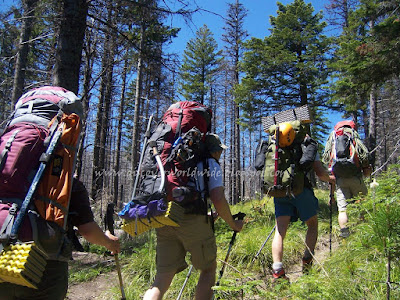Trekking (Backpacking)
Backpacking (Trekking) is the outdoor recreation of carrying gear on one's back, while hiking for more than a day. It is often but not always an extended journey,and may or may not involve camping outdoors. In North America tenting is common, while simple shelters and mountain huts found widely in Europe are rare. In New Zealand, tramping, is an equivalent term though overnight huts are frequently used. Hill walking is the equivalent in Britain, though backpackers make use of all kinds
of accommodation, in addition to camping. Backpackers use simple huts in
South Africa.Similar terms used in other countries are trekking and bushwalking. Trekking as a method of travel is a different activity, which mainly utilizes local transport during a journey which can last months.
Backpacking camps are usually more spartan than campsites where gear is
transported by car or boat. In areas with heavy backpacker traffic, a
hike-in campsite might have a fire ring (where permissible), an outhouse , a wooden bulletin board with a map and information about the trail and area. Many hike-in camps are no
more than level patches of ground free of underbrush. In remote windiness areas hikers must choose their own site. Established camps are rare and the ethos is to "leave no trace" when gone.
 Backpacking gear begins with a suitable backpack ,
proper both in size and fit. Next is clothing and footwear appropriate
for expected conditions. Third is an adequate amount and type of food.
Fourth is some form of sleep system (typically a sleeping bag and perhaps a foam pad). Fifth is some amount of survival gear, once again appropriate to the planned trip and skill-level of the backpacker. After that, everything is optional.
Backpacking gear begins with a suitable backpack ,
proper both in size and fit. Next is clothing and footwear appropriate
for expected conditions. Third is an adequate amount and type of food.
Fourth is some form of sleep system (typically a sleeping bag and perhaps a foam pad). Fifth is some amount of survival gear, once again appropriate to the planned trip and skill-level of the backpacker. After that, everything is optional.
A shelter appropriate to expected conditions is typically next.
Practical items not already mentioned - cook kit, stove, container for
water, a means of purifying it - are characteristically but not always
taken in some form. (Depending on the trip ready-to-eat foods may
suffice and suitable water be found along the way. More minimalist backpackers find ways to do with less, those willing to carry more do.)
Weight is always critical. A rule of thumb suggests a fully loaded
backpack should weigh no more than 25% of a person's weight. Every
single item is scrutinized, many removed the first time a pack is
hefted. Lightweight gear is widely available, which may or may not
sacrifice utility and durability but will always cost more. A wide
variety utilizing carbon fiber, lightweight alloys, specialty plastics,
and impregnated fabrics is available.
Proper hydration is critical to successful backpacking. Depending on conditions - which
include weather, terrain, load, and the hiker's age and fitness - a
backpacker needs anywhere from 2 to 8 litres (1/2 to 2 gallons), or
more, per day. At 1 kilogram (2.2 lb) per 1 litre (1.1 US qt). water is exceptionally heavy. It is impossible to carry more than a few days' supply.
Backpacking is energy intense. It is essential enough food is taken
to maintain both energy and health. As with gear, weight is critical.
Consequently, items with high food energy, long shelf life , and low mass and volume deliver the most utility. Satisfaction
is another consideration, of greater or lesser importance to all
hikers. Only they can decide whether it's worth the effort (and
trade-off against other gear) to carry fresh, heavy, or luxury food
items. The shorter the trip and easier the conditions the more feasible
such treats become.
In all cases, both kit and fuel necessary to prepare and serve
foodstuffs selected is part of the equation. Small liquid and gas fueled camp stoves and ultralight cooking pots are the norm. Increasingly campfires are prohibited.
While most backpackers consume at least some specially prepared
foods, many mainly rely on ordinary low moisture household items, such
as cold cereal, oatmeal, powdered milk, cheese, crackers, sausage,
salami, dried fruit, peanut butter, pasta, rice, and commercially
packaged dinner entrees.
Backpacking During Winter
Winter backpacking requires a higher level of skill and generally more specialized gear than in other seasons. Snow shows or skis may be required to traverse deep snow, orcrampons and an Ice Axe where needed. Winter sleeping bags and tents are essential, as are
waterproof, water-repellent, and moisture dissipating materials. Cotton
clothing retains moisture and chills the body, both particularly
dangerous in cold weather. Winter backpackers stick to wool or synthetic
fabric like nylon or polypropylene, which hold less moisture and often
have specialized wicking properties to dissipate sweat generated during
aerobic activities. Layering is essential, as wet clothes quickly sap
body heat and can lead to frostbite or hypothermia.


